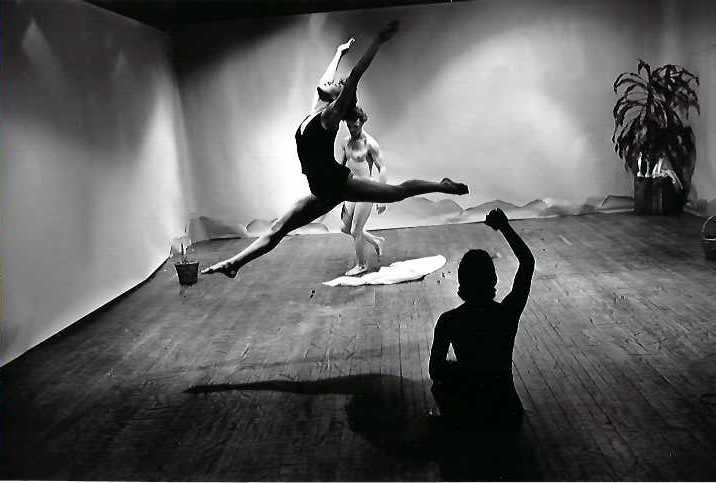
Title: Catches from a Stand
Duration: 13 minutes
Premiere: American Theater Laboratory, Dance Theater Workshop, NYC, NY 1977
Company: Hannah Kahn, Dalienne Majors and Dancers. Subsequently performed by Jessica Fogel and Dancers in several locations.
Dancers in premiere: Michael Blue Aiken, Hannah Kahn, Dalienne Majors.
Subsequent cast, Jessica Fogel and Dancers: Nancy Alfaro, Sally Hechinger, Daniel McCusker
Duration: 14 minutes
Music: Ceres Motion by David Borden, with an overlay of an excerpt from
Chants D’Auvergne: Vol. II, No. 2: L’Antouèno by Joseph Canteloube
Description:
The overriding feature of this work is its construction as a series of brief episodes separated by about 20 blackouts. This structure disoriented one’s sense of time and location. Occasionally, when the light returned after a blackout, the dancers would be found in the same position as before. In other instances, the return of the lights would find the dancers in a new location and activity. Evoking a beach setting (thus the word “strand” in the title), a male and female dancer wearing black bathing suits go about their familiar beach-lounging riffs as a couple, each unfurling white sheets/towels, sunbathing in a series of poses, applying suntan lotion, playing catch with an apple. Another female makes a dramatic entrance carrying a boom box blasting “You Make Me fell Like Dancing.” Wrapped in a white sheet, with a woven basket on her head, she walks in profile like an Egyptian queen. She catches the eye of the male, and there unfolds a tension between the three dancers as the two females spar for his attention. The game of catch expands into a trio. In one section, there is a diagonal line of the three dancers posing on their sheets in sunbathing positions as the heat builds. In another scene, the original female tosses and catches a ball downstage while watching the other two engage with each other. The mini-scenes accrue toward a dramatic climax. The title is filled with puns: catches from a strand, as if each scene were a pearl on a necklace/strand that are joined together by the necklace’s catches/fasteners. And catches from a strand, as in scenes from a beach. And catches/scenes from a strand/bind, because the tension of the trio left one of the women stranded. In fact, “catches” as a noun in its various meanings—“catching” a ball; a person as a good “catch” as a partner; “catches” as in a sudden pause due to high emotion—are implicit in the dance. This was the first work I created using David Borden’s music. It was layered with the Canteloube music towards the end of the work as well as the popular songs played on and off from the boombox.


Studio photo, Jessica Fogel and Daniel McCusker in Catches from a Strand

Catches from a Strand. Sally Hechinger, Daniel McCusker, Joanne Legano. DTW performance. Photo by CETA photographer Sarah Wells

Dance: Catches from a Strand. Location of photo: Manhattan Cable TV studio. Leaping dancer: Nancy Alfaro. Foreground: Joanne Legano. Background: Daniel McCusker. A video version was made of this dance. The video shoot was directed by Sally Hechinger.